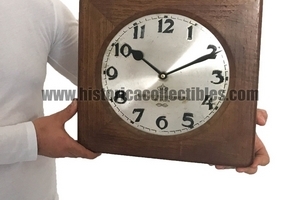Wall Clock, Royal Italian Military Arsenal - La Spezia (Italy), circa 1938
Large wall clock, made of wood and metal, around 1940, and used in the offices, laboratories or workshops of the Royal Maritime Military Arsenal of La Spezia (Italy).
Inside the clock, there is its original mechanism "Reform Breveté Swiss" produced in Switzerland, which adopts a self-winding spring movement with solenoid which, powered by a 4.5 volt battery, reacts to an electrical impulse every three minutes.
Perfectly working.
Its dimensions are: 40 cm x 40 cm.
Royal Maritime Military Arsenal La Spezia
Historically, it was Napoleon Bonaparte who first realized the possibility of building an arsenal in the Gulf of La Spezia. The Genoese architect Andrea Tagliafico was entrusted with the project.
Napoleon's idea was taken up again in 1857 by Cavour, at the time prime minister and minister of the Navy, who took care of finding the necessary funds and entrusted Domenico Chiodo, an officer of the military engineers, with the construction of the new naval base .
The works, which began in 1862, ended on 28 August 1869, when General Domenico Chiodo formally inaugurated the not yet completed plant, starting the flooding of the newly built basins. A system of conveniently located forts was then built to protect the Arsenal and the naval base.
During the First World War, from February 1917 a Seaplane Section arrived with 4 FBA Type Hs for the Royal Navy which from March 1918 became the 269th Squadron which remained until 1 June 1918.
Second World War
During the Second World War, due to its strategic importance, the arsenal was heavily bombed and was almost completely destroyed, but thanks to quick renovation works it returned to being operational already in the post-war period.
It was home, among other things, to the 2nd squad and the 10th MAS flotilla.


